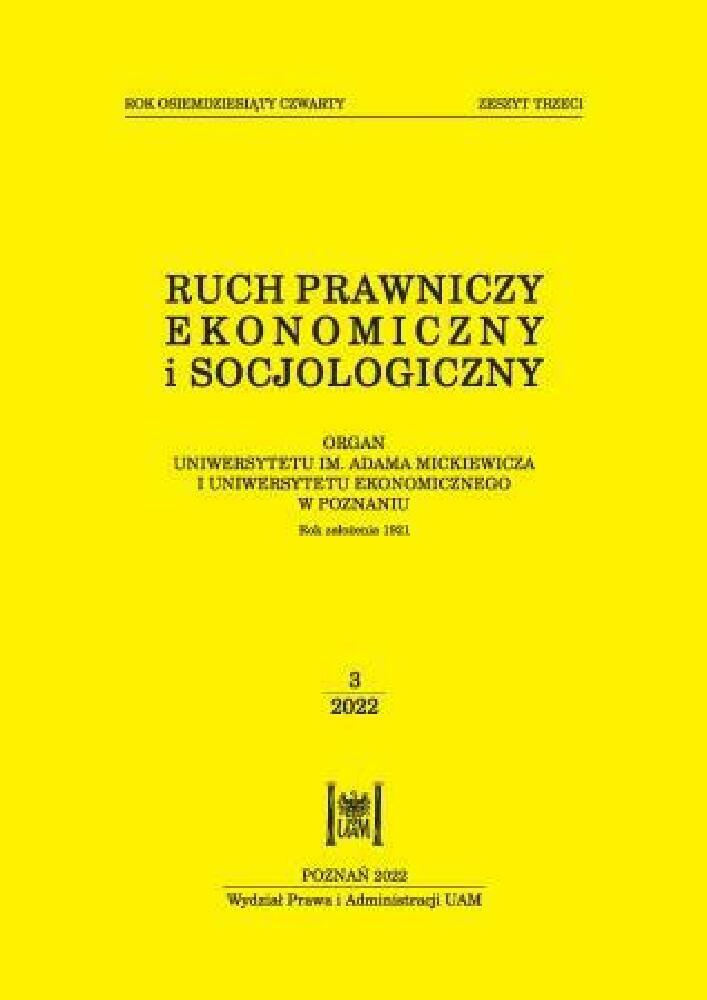Abstract
Since the Polish economy is facing new challenges, the debate on introducing the euro once again becomes relevant. Due to the fact that the nominal convergence criteria currently ‘differ’ from the macroeconomic reality even in the euro area itself, it is justified to pay attention to the conditions of real convergence. The aim of the study is to assess the convergence of Poland and the euro area from the perspective of the share of intra-industry trade, as well as the degree of convergence of cyclical fluctuations in these economies. Quantitative research methods were used in the work (statistical analysis). The conducted research shows that the share of IIT in Poland and the euro area (measured by the Grubel-Lloyd index) was characterized by a growing trend, which proves the intensification of trade integration. However, this growth halted at the end of 2016. The growing and relatively high convergence of cyclical fluctuations in the analysed economies (measured by the recursive correlation coefficient) was observed until the end of 2013. In the following years, a decline and then fluctuations in the degree of this convergence were noted. In this context, it should be emphasized that the degree of synchronization of fluctuations in the economic activity of Poland and the euro area was conditioned by specific, asymmetric events for a large part of the research period. In view of the research results obtained, it can be concluded that Poland is characterized by a ‘moderate’ degree of real convergence with the euro area, but it is not advisable to give a definitive and final assessment of the analysed phenomena and answer the question of whether this level is sufficient to introduce the common currency. Therefore, all the dilemmas justify the need to continue and expand research in this area.
References
Adamowicz, E., Dudek, S., Pachucki, D., Walczyk, K. (2008). Synchronizacja cyklu koniunkturalnego polskiej gospodarki z krajami strefy euro w kontekście struktury tych gospodarek. Warszawa: IRG SGH.
Beck, K. (2017). Zastosowanie filtrów do analizy cykli koniunkturalnych i synchronizacji cyklu koniunkturalnego Polski z krajami europejskimi. Wiadomości Statystyczne 10(677): 5–18.
Biegun, K. (2017), Ocena stabilizacyjnej roli zmian kursu walutowego w Polsce w kontekście potencjalnego członkostwa w strefie euro. Studia i Prace WNEIZ US 47/1: 81–93.
Borowski, J. (2001). Podatność Polski na szoki asymetryczne a proces akcesji do Unii Gospodarczej i Walutowej. Warszawa: NBP.
Bry, G., Boschan, C. (1971). Cyclical Analysis of Time Series: Selected Procedures and Computer Programs. New York: National Bureau of Economic Research.
Canova, F., Dellas, H. (1993). Trade interdependence and the international business cycle. Journal of International Economics 34: 23–47.
Fidrmuc, J. (2004). The endogeneity of the optimum currency area criteria, intra-industry trade, and EMU enlargement. Contemporary Economic Policy 22(1): 1–12.
Frankel, J.E., Rose, A. (1996). The endogeneity of the optimum currency area criteria. The Economic Journal 108: 1009–1025.
Gomez, V., Maravall, A. (2001). Seasonal adjustment and signal extraction in economic time series, [w:] D. Pena, G.C. Tiao, R.S. Tsay (eds.), A Course in Time Series Analysis. New York: 202–236.
Greenaway, D., Hine, R., Milner, C. (1995). Vertical and horizontal intra-industry trade: a cross industry analysis for the United Kingdom. The Economic Journal 105(433): 1505–1518.
Gryczka, M. (2018). Wpływ zmian kursu walutowego na wartość eksportu towarowego wybranych krajów. Przedsiębiorczość i Zarządzanie 19(2, 2): 51–66.
Hamulczuk, M., Gędek, S., Klimkowski, C., Stańsko, S. (2012). Prognozowanie cen surowców rolnych na podstawie zależności przyczynowych. Warszawa: Instytut Ekonomiki Rolnictwa i Gospodarki Żywnościowej, Państwowy Instytut Badawczy.
Hodrick, R., Prescott, E. (1997). Postwar U.S. business cycles: an empirical investigation. Journal of Money, Credit and Banking 29(1): 1–16.
Hughes Hallett, A., Piscitelli, L. (2002). Does trade integration cause convergence? Economics Letters 75: 165–170.
Kołodko, G. (2020). Od ekonomicznej teorii do politycznej praktyki. Warszawa: Poltext.
Kotliński, K., Warżała, R. (2013). Synchronizacja cykli koniunkturalnych jako kryterium członkostwa w strefie euro. Ekonomia 34: 49–64.
Krugman, P. (1993). Lesson from Massachusetts for EMU, [w:] F. Torres, F. Giavazzi (eds.), Adjustment and Growth in the European Monetary Union. New York: 241–266.
Kufel, T. (2013). Ekonometria. Rozwiązywanie problemów z wykorzystaniem programu GRETL. Warszawa: PWN.
Kufel, T., Osińska, M., Błażejowski, M., Kufel, P. (2014). Analiza porównawcza wybranych filtrów w analizie synchronizacji cyklu koniunkturalnego. Prace Naukowe Uniwersytetu Ekonomicznego we Wrocławiu 328: 41–50.
Markowski, Ł. (2021). Wpływ zmian kursu walutowego na sferę realną polskiej gospodarki w latach 2010–2019. Acta Universitatis Lodziensis. Folia Oeconomica 3(354): 81–100.
Molendowski, E., Polan, W. (2015). Zmiany pozycji konkurencyjnej Polski w handlu wewnątrzgałęziowym z krajami UE-15 przed akcesją i po niej, [w:] E. Małuszyńska, G. Mazur, I. Musiałkowska (red.), Polska – 10 lat członkostwa w Unii Europejskiej. Poznań: 90–105.
Papageorgiou, T., Michaelides, P.G., Milios, J.G. (2010). Business cycles synchronization and clustering in Europe. Journal of Economics and Business 62: 419–470.
Piłat, K. (2017). Synchronizacja wahań koniunkturalnych krajów Europy Środkowo‑Wschodniej ze strefą euro. Acta Universitas Lodzensis. Folia Oeconomica 2(328): 201–216.
Salamaga, M. (2018). Modelowanie dynamicznych zależności pomiędzy bezpośrednimi inwestycjami zagranicznymi i handlem wewnątrzgałęziowym w Polsce. Zeszyty Naukowe Uniwersytetu Ekonomicznego w Katowicach 4(976): 145–159.
Stefański, R. (2008). Synchronizacja cyklu koniunkturalnego a realna konwergencja Polski ze strefą euro. Ruch Prawniczy, Ekonomiczny i Socjologiczny 70(4): 129–149.
Warżała, R. (2016). Cykle koniunkturalne w polskich regionach. Studium teoretyczno-empiryczne. Olsztyn: UWM.
Warżała, R. (2018). Zbieżność cykli koniunkturalnych krajów Europy Środkowej i Wschodniej z cyklem dwunastu krajów Unii Europejskiej. Prace i Materiały Instytutu Rozwoju Gospodarczego 100 (Wydanie jubileuszowe dedykowane profesor Elżbiecie Adamowicz). Warszawa: 143–169.
Witkowska, D., Matuszewska, A., Kompa, K. (2008). Wprowadzenie do ekonometrii dynamicznej i finansowej. Warszawa: SGGW.
License
Copyright (c) 2022 WPiA UAM

This work is licensed under a Creative Commons Attribution-NonCommercial-NoDerivatives 4.0 International License.





